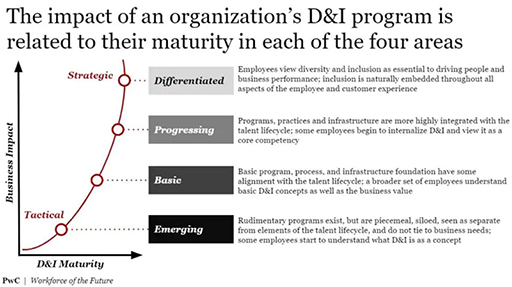2.1 Strategy setting tools
There are several tools you can use to analyse your current diversity and inclusion activities and to help you work towards a strategy for the future.
Most of us have heard of a SWOT analysis, but have you heard of the SOAR analysis? It takes a very similar approach, but strives to be more forward thinking, a useful attribute when working with diversity and inclusion.
SOAR analysis
Quick Books Canada (no date) explains that while a SWOT analysis ‘takes a look at where a company is, SOAR strives to be forward thinking to address the potential of the business. By eliminating weaknesses and threats, SOAR focuses on positive elements more likely to be influenced by the company.’
They also describe SOAR as ‘a stronger option for younger, less-developed companies’, and ‘more beneficial for organisations striving for a breakthrough or innovation as opposed to incremental improvement.’
SOAR stands for:
- Strengths – what can we build on?
- Opportunities – what can we leverage for success?
- Aspirations – what do we want to achieve?
- Results – how will we know we are succeeding?
Miro (no date) suggests using a SOAR analysis when you want to bring people together and encourage them to take action – a core element of a successful diversity and inclusion agenda.
They propose several questions to ask during a SOAR analysis:
- What are our greatest strengths?
- What are our best opportunities for growth?
- What are our best opportunities for success?
- What future are we working towards?
- What measurable results will show us that we have achieved that vision of the future?
In the context of diversity, Stavros and Cole (2015) explain that SOAR ‘promotes an inclusive environment that facilitates positive performance among diverse teams in which strategy is a dynamic and generative process that focuses on strengths, whole system solutions, and stakeholder inclusion’.
Another way to assess your organisation, and to consider future strategy, is to use a diversity and inclusion maturity model.
Diversity and Inclusion maturity models
As Tapia et al (2020) explain, these models are useful ‘because they offer a simple yet comprehensive current snapshot of how mature an organisation is in diversity and inclusion.’ They can also be an ‘effective strategy setting tool to create a roadmap of where the organisation wants to go and at what pace.’
Here is an example of a diversity and inclusion (D&I) maturity model from PwC (Karren & Lee, 2018).
Once you’ve identified which of the four areas your organisation currently sits in, the aim is to move towards ‘differentiated’, i.e. fully mature. Karren & Lee go on to explain that a company can ‘only ascend the D&I maturity curve when supported (and pushed) by sound data collection and analytics’. They describe the main drivers for successful organisations as:
- robust metrics
- business-focused strategies
- leadership alignment
- integrated talent processes.
This is a very brief introduction to a detailed modelling approach. There will be another opportunity to explore this type of tool further in Activity 6, or find the link to Karen & Lee’s article in References.
In the next section, you’ll look at metrics and data in more detail.


